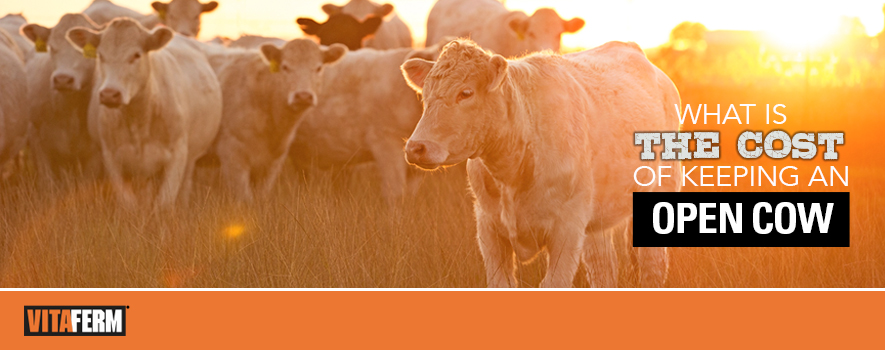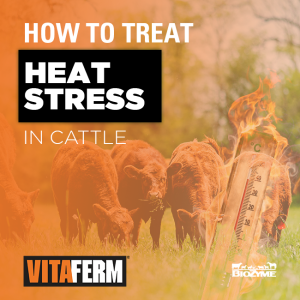
Financial survival as a cow-calf producer is like a game of Risk. Producers have a lot of factors to consider each year, and without a doubt, one of those decisions will be what the cost is to keep an open cow in the herd.
First, the particular segment a producer is in needs to be considered. A purebred producer who decides to keep an open cow over for another breeding season will likely be able to recover the extra cost of a non-producing cow with the sale of the next calf. However, rarely will a commercial cow-calf producer recover the cow expense if he or she decides to keep an open cow and rebreed her the next year.
“It is often the inclination of the producer that the cow won’t bring in much money if he sells her open, so he will hold onto her and rebreed her next year,” said Kevin Glaubius, Director of Nutrition at BioZyme® Inc. “That typically makes for a really expensive cow and is rarely profitable in a commercial setting.”
Producers should preg check their cows as early as possible and consider their options. It is safe to preg check 30-40 days after the cows’ last exposure. And once a cow is confirmed open, it is time to consider culling her, so you don’t spend another 3-4 months on feed and uptake on non-productive cow days.
Glaubius offers some simple “cowboy math” in calculating the cost of culling and replacing an open cow versus feeding an open cow. The numbers below came from the Midwest on March 10, 2018.
Initially, the producer is going to spend an average of $500-$700 per year, per cow on feed and upkeep. This is variable on labor, resources available and other geographic and environmental factors. Then, if a cow is open, you lose the revenue from a calf that won’t wean and sell this season. Currently, you could calculate a 550-pound calf would bring about $1.80 per pound, so the producer is losing about $990 in calf revenue. The total cost for one year of keeping the open cow is as about $1600:
$600 (cow cost) + $990 (calf revenue) = $1,590 (Expense for keeping open cow)
A better option would be to sell the open cow and replace her with a bred heifer or cow. March 10, 2018, market numbers showed cull cow prices at 64 cents per pound. Average cow size is between 1,200-1,300 pounds, so a 1,250-pound cow will have a salvage value of around $800. A bred replacement female will cost about $1,200 with the goal to have a calf to sell at weaning time.
$1,200 (replacement cow) – $800 (salvage cow income) = $400 (Expense for replacing open cow)
With almost a $1,200 difference in keeping an open cow or replacing her, it seems like an easy option to replace her. Although 100% conception is a great management goal, isn’t always realistic. However, Glaubius says the sooner you cull the open cows, the less you will have to invest in their feed bill, and he notes that cull cow prices almost always decline the further into fall and winter, so he suggests selling as early as you can, saying September has traditionally recorded the best prices for cull cows. There are a lot of issues that lead to open cows – age, health, reproductive issues, heat stress.
“If you don’t know your cow is open, you can’t control costs, that’s why it is a good idea to preg check at weaning. The guy who preg checks first gets his open cows to town first and gets the most money for his cull cows. And he wins on both fronts, because he isn’t pouring extra feed costs into the cows for two, three, four months,” Glaubius said. “Cows need to be nursing a calf or pregnant in order to measure their productivity – much like the swine industry. The ‘non-producing cow days’ are what cost the producer the most.”
But, what if you didn’t have to think about open cows because of increased conception rates? Glaubius offers four tips to getting your cows bred and keeping them bred.
- Consider a quality mineral program. A premium mineral program is a good investment that will see a great ROI with a cow that gets bred and stays bred. Don’t set cows up for failure initially but invest in a good mineral program like VitaFerm®. VitaFerm supplements contain Amaferm®, a natural prebiotic designed to maximize the nutritional value of feed. With the Amaferm advantage, producers will see increased intake, digestibility and absorption.
- A mineral program alone won’t aid in conception. Cows need to be fed the proper amounts of energy and protein, so they are in the right condition to breed successfully. Nine out ten breeding failures are usually due to energy or protein deficiencies and not the mineral, according to Glaubius. If you don’t feed energy and protein correctly, mineral won’t fix poor body condition. Most nutrition companies, including BioZyme, offer some type of ration and forage testing services. If you aren’t sure your cows’ dietary needs are being met, be sure to take feed samples and have them tested.
- Herd health protocols are key. Working with your veterinarian to keep your herd healthy is of upmost importance. Making sure the cow has proper vaccinations, preventing common challenges like anaplasmosis, and making sure the cow stays bred is vital. Sometimes the cow will abort due to viruses, infections and illnesses that are preventable or treatable.
- Another way to make sure the cow stays bred through the summer months is to minimize the heat stress she incurs. The cow will often reabsorb the fetus when she faces multiple 100-degree days, ending up open.
VitaFerm® offers two mineral options to help get cows bred and keep them bred, especially in the summer’s heat. First is the VitaFerm Concept•Aid®, a line of vitamin and mineral supplements for cattle formulated to promote effective, easy breeding when fed 60 days pre-calving through 60 days post-breeding. High concentrations of vitamin E and organic trace minerals, coupled with the Amaferm advantage, supports quick repair of the reproductive tract and more energy for reproductive success. Additionally, increased nutrient absorption and digestion leads to healthier and heavier calves giving you performance that pays.
The next is VitaFerm HEAT®, a line of vitamin and mineral supplements for cattle used to reduce heat stress during temperatures of 70 degrees and above, or anytime cattle are grazing fescue. With Amaferm and Capsaicin, both research-proven to lower body temperature, conception rates should improve by maintaining pregnancy. HEAT also includes garlic, to deter insects.
Deciding if you should keep an open cow or not can be a big decision. But if you maximize your odds of increased conception and pregnancy, these are decisions that you won’t have to make as often.



